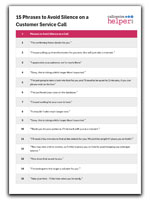Megan Jones shares hints and tips on how advisors can bridge silence on a call to deliver the best customer service possible even in difficult situations.
Silence is a daily occurrence in every contact centre, wasting valuable time and compromising Average Handling Time (AHT) metrics.
Whilst building rapport is a great strategy for avoiding moments of dead air, there are a handful of other common situations where agents will need to think fast to stop silence from compromising the customer experience.
20 Ways to Avoid Dead Air on in Customer Service Calls
Here are some strategies to help agents bridge silence on a call – no matter what the reason.
1. Bridge Silence on a Call When an Agent is Busy Completing a Task
When agents need a moment to complete a task during a call, silent pauses can create an uncomfortable experience for the caller, potentially leading to impatience or frustration.
To keep the conversation flowing, agents can use bridging statements that acknowledge the pause while keeping the caller informed.
For example, saying, “I’m just pulling up that information for you now, this will just take a moment,” reassures the caller that the agent is actively working on their request. This approach builds rapport and maintains engagement, minimizing any feelings of being left on hold.
Incorporating small, purposeful updates throughout the task can also help bridge silence. Phrases like, “I’m confirming those details for you,” or “I appreciate your patience; we’re nearly there,” signal progress and keep the customer involved in the process.
By keeping the caller informed, agents can transform otherwise quiet moments into opportunities to reinforce the quality of service, demonstrating attentiveness and care even while multitasking.
2. Prepare Customers for Brief Periods of Silence
One way to help overcome dead air whilst completing a task – without filling the time with small talk and compromising the ability for the agent to complete the task in hand – is for the agent to let the customer know there’s about to be a period of silence and to be honest about how long it will take.
For example, “I’m just going to take a look into that for you and I’ll need to be quiet for 2 minutes, if you can please wait on the line” sets far more realistic expectations, is better than pretending “I’ll be right back”, and will be far easier to come back from afterwards – without compromising rapport.
To find out more about managing customer expectations, read our article: How to Set the Right Expectations on a Call
3. Use Simple Updates to Ease Silent Pauses
It can also be helpful during a brief period of silence for the agent to offer a running commentary to reassure them that they are still there, with regular updates such as:
- “I’ve just found your case on the database.”
- “I’m just waiting for your case to load.”
- “It shouldn’t take much longer now.”
- “Sorry, this is taking a little longer than I expected.”
- “Thank you for your patience, I’ll be back with you in a moment.”
Note, these comments don’t have to specifically explain what the agent is doing, the purpose is to avoid the customer having to sit uncomfortably “in the dark” for the agent to return to their conversation.
It’s equally important that these updates are statements and not questions, so as not to invite small talk and distract the agent from the task in hand.
4. Think Ahead and Keep the Customer Busy Too
Whilst an agent is busy in the background, keep the customer busy too.
Another way to bridge any periods of silence whilst an agent is busy in the background is to keep the customer busy too, if possible, as Sunil Parshotam, Service Standards Manager at UCAS, commented:
“Think ahead – is there any further information you may need from the caller later on that they could find during this time.”
5. Make Use of the “On Hold” Options

All of the above can help for short, anticipated periods of silence, but if the agent knows they are going to be busy for a considerable time, sometimes it’s best to revert to putting the customer on hold sooner rather than later.
This is a more comfortable way to bridge a period of silence than to leave them waiting on the end of the line for you to return, as Sunil Parshotam said:
“If you need more time to investigate or find out the answer to their question, check if the caller is happy to be placed on hold while you do this.
“Get all the information you need before placing them on hold if they are happy, so you don’t have to keep going back to them. Ideally, you’d only want to put them on hold once so the call flows as efficiently as possible.“
For Example:
- “I’ll need a few minutes to find all the details for you. Would it be alright if I place you on hold?”
- “This may take a bit to resolve, so I’d like to place you on hold to avoid keeping you waiting in silence”
For more information on how you can reduce the time a customer is on hold, read our article: How to Reduce Hold Time in Your Contact Centre
6. Bridging Silence on a Call When an Agent Doesn’t Know the Answer
When an agent doesn’t know the answer, acknowledging it with a reassuring phrase like, “That’s a great question – let me check on that for you,” helps maintain trust. This approach keeps the caller informed and shows commitment to finding a solution, rather than leaving them in silence.
While the agent looks up the information, brief updates such as, “I’m checking our resources for you,” prevent dead air and keep the caller engaged. This simple strategy keeps the conversation flowing, reassuring the caller that the agent values both accuracy and attentiveness.
7. Remind Agents They Don’t Always Need to Know the Answers
Agents should understand that it’s perfectly okay not to have every answer on the spot. By reassuring them of this, they’re less likely to feel pressured or anxious about manager expectations and can focus instead on handling the silence confidently.
Encouraging agents to acknowledge when they need to look up information or consult resources fosters an atmosphere of transparency, allowing them to maintain rapport with the customer while actively working toward a solution.
8. Encourage Them to Pretend “It’s Only Their First Week”
When an agent doesn’t know the answer, to avoid dead air, pretending they are a new starter can help an agent play the situation to their advantage, get some sympathy from the customer and keep them on side whilst they figure out what to do next.
Even if they’ve been in the role 6 months, there’s no harm in twisting the truth a bit if it helps give agents the confidence and space they need to find a solution and get the conversation back on track.
Note, this approach will be far more effective if agents are confident in their understanding of their escalation channels and where to find the information that they need. This could even be printed out for them to have to hand in the event of an emergency.
To find out more about how you can improve the knowledge of your advisors, read our article 14 Practical Techniques to Improve Knowledge Management
9. Bridge Silence on a Call When a Customer is Shocked by the Price
When a customer reacts with silence after hearing a price, it’s crucial for the agent to address their hesitation with empathy and understanding.
By saying something like, “I understand that may have been more than expected – let me explain what’s included,” the agent can bridge the silence and invite the customer to discuss their concerns openly.
This approach not only helps ease the initial shock but also shifts the conversation toward the value of the product or service.
Following up with specific benefits or alternative options can further engage the customer. Statements like, “There are also some flexible options available,” or “Let’s go over what might fit your needs best,” can help the customer feel more at ease.
By proactively addressing the silence, the agent demonstrates a willingness to work within the customer’s needs and build trust.
10. Ask “Is That What You Expected?”

“When a customer hears the price, it may cause a silent reaction, and so the agent will ask things like “Is that what you expected?”, “How does that sound to you?”, “Have you been shopping around?”
“The agent will then use their price objection handling scripts to help move the call forward,” as Linda Davis, Head of Operations at AllClear Insurance Services, commented.
11. Bridge Silence on a Call With an Angry Customer
When a customer is angry, silence can escalate tension, so it’s essential for the agent to acknowledge their frustration calmly and empathetically.
Starting with phrases like, “I can see why you’re upset, and I’m here to help,” bridges the silence and shows that the agent is attentive and willing to listen. This approach helps to de-escalate emotions, making the customer feel heard and understood.
As the conversation progresses, gentle updates such as, “I’m looking into this to get a solution for you,” can reassure the customer that their issue is being taken seriously.
These small interjections prevent silence from intensifying the anger and keep the caller engaged, allowing the agent to steer the conversation toward a resolution.
12. Allow for a Natural Pause After the Customer Has Made a Complaint

Not every period of silence needs to be instantly filled, especially during a complaints call, as Gary Kinsella, Head of Customer Services at Dignity Funerals Ltd, commented:
“Silence can be very powerful and I’m a big believer in using it in complaint calls. Often customers complaining have a script in their head and want to ensure that they cover off everything. Interrupting sometimes frustrates the customer and throws them off track.
“Let them finish what they have to say by allowing that silence. A pause will help the agent and customer know that it’s time to respond.”
13. Acknowledge the Silence – Don’t Ignore It

It’s then important to acknowledge the silence in order to move the conversation forward, as Mark McGill, Operations Manager at SSE Retail at Ovo Energy, said:
“In instances where the customer is angry, it’s sometimes better you allow them to get everything out. Finish with silence and be able to come in after the customer says ‘you still there?’ to say ‘Yes absolutely, I just wanted to understand your query in full.
To recap x, y and z. I will be able to resolve this for you and will start with…’. Too often we antagonize the situation by coming in too quickly.”
To learn more about handling customer complaints, read our article: 21 Ways to Improve Complaints Handling in Your Contact Centre
14. Take Control of the Situation and Reassure Customer
Sometimes customers will also go quiet if they don’t like what has been said and perhaps haven’t received the outcome they were hoping for. In instances like this, it’s important agents take control in a calm manner to reassure the customer.
For example, by reminding the customer that they are here to help, apologizing that their concerns are causing them to feel this way, and suggesting that they can talk through the different options to find a solution to their query.
15. Tell the Customer “It’s OK if They Need a Moment”
If a customer falls silent, the agent can gently acknowledge this pause by letting them know it’s perfectly fine to take a moment to process the information.
By saying, “Take your time – I’ll be here when you’re ready,” the agent reduces any pressure the customer may feel, creating a more comfortable, supportive atmosphere.
Additionally, offering a callback option can give the customer time to think things over at their own pace, showing that the agent values their comfort and is flexible in meeting their needs. This approach not only builds trust but also conveys empathy, making the conversation feel more customer-centered.
16. Maintain Sensitivity and Signpost After Silence
If a customer chooses to continue the call after a tense or silent moment, agents should respond with heightened sensitivity, recognizing that the interaction may still feel delicate.
Linda Davis advises that “the agent should be very aware that the situation is now sensitive, and deliberately slow down the conversation and fill any further silent gaps with additional signposting such as “I will shortly take your trip details”, “we are nearly finished”, and ”we are almost done.”
This deliberate approach builds trust and shows that the agent respects the customer’s emotional state, fostering a smoother, more considerate interaction.
For hints and tips on how to build rapport with angry customers, read our article: Rapport Building With Angry Customers – With Examples
17. Bridge Silence on a Call When the Customer is Experiencing Technical Difficulties
When customers face technical issues on a call, silence can increase their frustration or confusion. Agents can bridge this gap with reassuring statements like, “I’m here whenever you’re ready,” letting the customer know they’re supported despite the delay.
Offering simple suggestions, such as, “If you’re able to check your connection, I’ll wait here,” keeps the customer engaged and focused. This approach shows patience and empathy, making it clear that the agent values the customer’s experience, even when technical issues arise.
18. Ensure Clarity When Call Signal Is Poor
If the signal is poor and silence interrupts the call, missing important information, it’s essential for the agent to quickly acknowledge the issue and work with the customer to address it.
For instance, the agent might say, “I’m having a bit of trouble hearing you – if you’re able to move to a spot with a stronger signal, that might help,” and then politely ask them to repeat any missed information to ensure nothing is lost.
During these moments, it can also be useful for the agent to take brief notes to piece together a full and accurate picture of the customer’s needs.
This way, if information has been missed or repeated due to connection issues, the agent can clarify details more easily, making the interaction smoother and more productive for the customer.
19. Ask for an Alternative Phone Number
If the agent can still only hear the customer patchily, they could try asking for an alternative phone number to call the customer back on. Or the agent could also try transferring the call to one of their colleagues.
If the connection remains poor and the agent can only hear the customer intermittently, requesting an alternative phone number can help ensure a clearer conversation.
The agent might say, “It sounds like the connection is still spotty – would there be a better number I could reach you on?”
If that’s not possible, the agent could offer to transfer the call to a colleague who might have better call stability, ensuring the customer’s needs are met without further interruptions. This proactive approach minimizes frustration and keeps the conversation moving smoothly.
20. Suggest a Different Channel
If the issue persists, it may be best for an agent to cut their losses and switch to another channel.
The agent should be as clear as possible about their plans to disconnect the call (and hope the customer hears them) before using information in their Case Management System (CMS) to follow up with the customer via email instead.
Printable – 15 Phrases to Avoid Silence on a Customer Service Call
Do you want to download these statements to share with your team?
Get your free download of 15 Phrases to Avoid Silence on a Customer Service Call now:
For more advice on how to improve the customer experience and manage how calls are handled, read our articles:
- “I’d Like to Speak to a Manager” – 7 Ways to Deal With Difficult Customers
- 18 Empathy Statements That Help Improve Customer–Agent Rapport
- 28 Brilliant Hacks to Improve Contact Centre Efficiency
Author: Charlie Mitchell
Reviewed by: Hannah Swankie
Published On: 7th Jul 2021 - Last modified: 29th Oct 2024
Read more about - Skills, Call Handling, Communication, Customer Service, CX, Downloads, Editor's Picks, Gary Kinsella, Linda Davis, Mark McGill, Printable









































